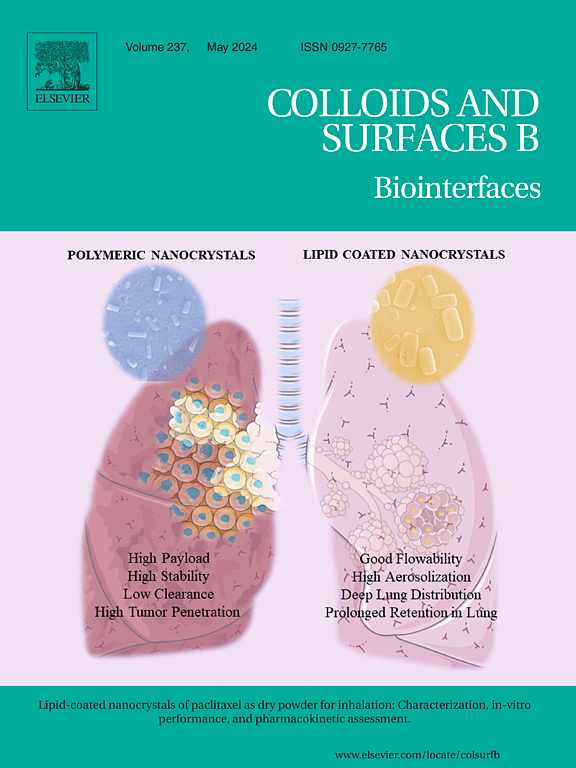Engineered exosomes with enriched miR-23b suppress the progression of periodontitis by reprogramming macrophages
IF 5.4
2区 医学
Q1 BIOPHYSICS
引用次数: 0
Abstract
Periodontitis is a prevalent inflammatory disease that damages the tooth-supporting structure, leading to tooth instability and loss. Conventional therapies target biofilms but fail to address immune dysregulation, highlighting the need of host-modulating strategies. Herein, the decreased miR-23b level was found to be associated with the progression of periodontitis and identified as a potential therapeutic agent for the disease. Since the conventional methods of loading exogenous miRNAs into exosomes may impair the membrane structure, a miR-23b-overexpressed HEK293T cell line was constructed to produce engineered exosomes with enriched miR-23b (namely miR-23b-Exo). The miR-23b-Exo modulated the NF-κB signaling pathway in macrophages, thereby promoting the M2 polarization and suppressing the release of inflammatory cytokines to execute the anti-inflammatory effect. In rats with periodontitis, miR-23b-Exo alleviated the inflammation-induced periodontal damage, exhibiting favorable anti-periodontitis efficacy. Our study provides a promising host-modulating strategy based on the engineered exosomes-mediated miR-23b delivery, thereby alleviating periodontal damage by reprogramming macrophages.
富miR-23b的工程外泌体通过重编程巨噬细胞抑制牙周炎的进展
牙周炎是一种常见的炎症性疾病,它会损害牙齿的支撑结构,导致牙齿不稳定和脱落。传统疗法针对生物膜,但未能解决免疫失调,强调需要宿主调节策略。在这里,miR-23b水平的降低被发现与牙周炎的进展有关,并被确定为该疾病的潜在治疗剂。由于将外源性mirna加载到外泌体的常规方法可能会破坏膜结构,因此构建了miR-23b过表达的HEK293T细胞系,以产生富含miR-23b的工程外泌体(即miR-23b- exo)。miR-23b-Exo通过调控巨噬细胞NF-κB信号通路,促进M2极化,抑制炎症细胞因子的释放,发挥抗炎作用。在牙周炎大鼠中,miR-23b-Exo可减轻炎症引起的牙周损伤,具有良好的抗牙周炎作用。我们的研究提供了一种基于工程外泌体介导的miR-23b递送的有前途的宿主调节策略,从而通过重编程巨噬细胞减轻牙周损伤。
本文章由计算机程序翻译,如有差异,请以英文原文为准。
求助全文
约1分钟内获得全文
求助全文
来源期刊

Colloids and Surfaces B: Biointerfaces
生物-材料科学:生物材料
CiteScore
11.10
自引率
3.40%
发文量
730
审稿时长
42 days
期刊介绍:
Colloids and Surfaces B: Biointerfaces is an international journal devoted to fundamental and applied research on colloid and interfacial phenomena in relation to systems of biological origin, having particular relevance to the medical, pharmaceutical, biotechnological, food and cosmetic fields.
Submissions that: (1) deal solely with biological phenomena and do not describe the physico-chemical or colloid-chemical background and/or mechanism of the phenomena, and (2) deal solely with colloid/interfacial phenomena and do not have appropriate biological content or relevance, are outside the scope of the journal and will not be considered for publication.
The journal publishes regular research papers, reviews, short communications and invited perspective articles, called BioInterface Perspectives. The BioInterface Perspective provide researchers the opportunity to review their own work, as well as provide insight into the work of others that inspired and influenced the author. Regular articles should have a maximum total length of 6,000 words. In addition, a (combined) maximum of 8 normal-sized figures and/or tables is allowed (so for instance 3 tables and 5 figures). For multiple-panel figures each set of two panels equates to one figure. Short communications should not exceed half of the above. It is required to give on the article cover page a short statistical summary of the article listing the total number of words and tables/figures.
 求助内容:
求助内容: 应助结果提醒方式:
应助结果提醒方式:


